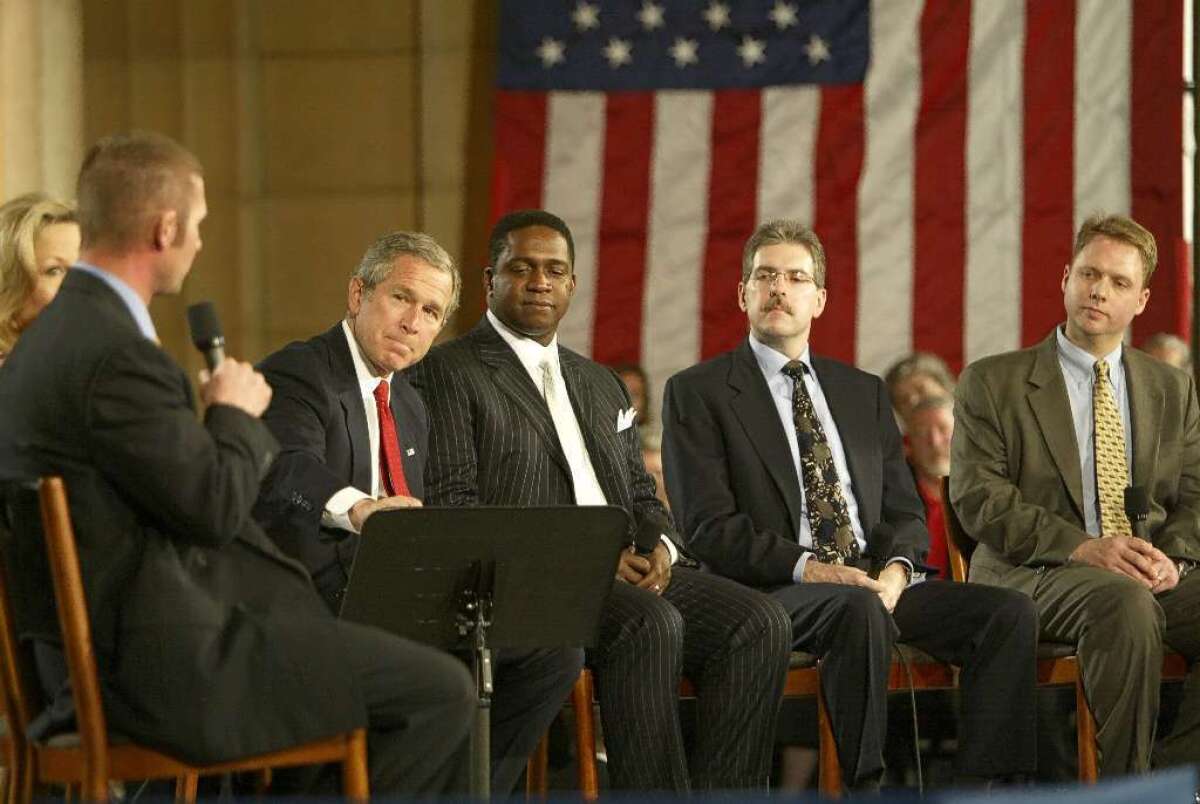Andrew Biggs: I’m not contemptuous of the working class, but right!

- Share via
Andrew Biggs of the American Enterprise Institute, whose disdainful take on the plight of older workers I described this week as “fatuous and flatly untrue,” defended his position Thursday as “substantively ... correct.”
We can’t both be right on this, so let’s take a look at his evidence. I think you’ll find it doesn’t stand up to scrutiny.
To recap, Biggs said in testimony before a Senate subcommittee Wednesday that there shouldn’t be a problem in raising the retirement age for Social Security from 66 to 67 between 2017 and 2022.
He observed that the average age at which people claimed Social Security back in 1950 was 68. Today it’s 63, even though older workers are healthier than they were in the past and hold less strenuous jobs. The biggest risk for older workers today, he cracked, is “carpal tunnel syndrome from your mouse or something like that.”
In his blog post at aei-ideas.org and in an email to me, he objects to my calling his take “fatuous.” (Websters: “silly, foolish.”) But he cops to his words being “a bit snarky.”
More substantively, he says that the fact that yesterday’s workers did work longer is proof that today’s can work longer.
Is it really that simple? Biggs himself, in a 2010 paper, acknowledged that among the reasons people waited longer in 1950 to claim their Social Security benefits was because the law was different. Early retirement (that is, as early as 62 rather than waiting until the normal retirement age of 65) wasn’t allowed then; it was only instituted in 1956 for women and 1961 for men.
Social Security’s earnings rules were much tighter then -- even a small amount of outside income could disqualify you from receiving benefits. “In response, individuals generally waited until they were fully withdrawn from the labor force before claiming Social Security,” he wrote.
Biggs included a chart demonstrating that there must have been a huge latent demand for early retirement in the 1950s. The average age of benefit claiming plummeted from 68 in 1950 to 65.3 in 1965. By 1970 it had settled in the range of 63 to 64, where it remains today. (The underlying data from the Social Security Administration can be found here.)
In other words, it appears that older workers in 1950 didn’t put off retirement because they wanted to, but because they had to.
Biggs also asserts that my analysis of working conditions for older workers relies too much on a study by the Center for Economic and Policy Research, which he says is overly liberal in its description of what constitutes “physically demanding” work. He prefers work by the Urban Institute, which subdivided jobs into those imposing “high general physical demands” and “any general physical demands” and found that only 6-7% of older workers were in the former category and 46% in the overall category.
Biggs’ argument is that only the “high demand” jobs should be counted as physically demanding, and therefore that he’s got a right to characterize the older worker as one typically facing minimal physical challenges. That’s his privilege as a debater, of course, but it seems rather a stretch even to go from 46% of older workers facing “any general physical demands” on the job to dismissing them as facing nothing more serious than “carpal tunnel syndrome from your mouse.” One suspects that a large proportion of that 46% would beg to differ.
None of this changes the basic point that raising the early retirement age is a lousy idea. Our standards for many social conditions have changed since 1950, and the amendments to Social Security’s retirement age rules presumably reflected Congress’s conclusion that people were forced to wait too long to retire. Why we should return to 1950 standards today even though they were revised in 1956, Biggs doesn’t explain.
The entire discussion about the retirement age is, in fact, just a proxy for something much more insidious -- the notion that we should pare back social programs that mostly benefit middle- and working-class Americans just to protect the wealth of the upper class.
Anyway, if you really want to hold up 1950 as a benchmark of public policy, try this: The top income tax rate then was 91%, imposed on incomes over $200,000. (That would be about $2 million today.) The wealthy did pay that rate then (and economic growth didn’t seem to suffer.) Isn’t that proof that they can pay the same rate today? AEI, the ball’s in your court.
More to Read
Inside the business of entertainment
The Wide Shot brings you news, analysis and insights on everything from streaming wars to production — and what it all means for the future.
You may occasionally receive promotional content from the Los Angeles Times.











